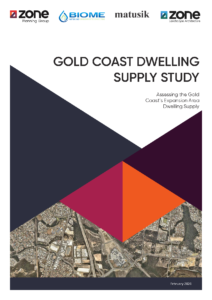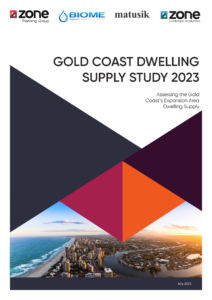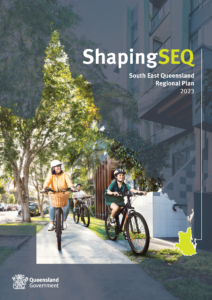Here at Zone Planning Group, we actively participate in consultation exercises for various planning instruments including Local Government planning schemes, State legislation and regional planning policies.
We think there is an obligation on all town planning consultancy firms to actively participate in draft planning policy rather than just complaining about flawed policy once it has been introduced.
Our particular interest relates to dwelling supply and housing affordability issues which we have been banging on about for many years.
We have, in consultation with Michael Matusik , Biome Consulting Group and Zone Landscape Architecture undertaken 2 reports in 2021 and 2023 which undertook a stocktake of greenfield dwelling supply in the City of Gold Coast, and conducted two industry functions regarding the findings of those reports.


Gold Coast Dwelling Supply Studies – 2020 & 2023
The findings on both occasions was that the amount of greenfield dwelling supply on the Gold Coast has been significantly overstated and that local and state documents had failed to take into account environmental and natural hazard constraints, and had made assumptions about higher density residential outcomes which do not align with the economic realities of the development industry.
We suspect that these same flawed assumptions have caused future dwelling supply numbers to be overstated in other Local Government jurisdictions in South East Queensland.
As we are all aware, South East Queensland and the Gold Coast in particular, is suffering from a significant dwelling supply shortage and housing affordability problem, which has been regularly referred to as a ‘crisis’.
We don’t need to remind you of stories relating to rent increases and homelessness, because this topic is covered by the media every day, let alone witnessed firsthand when we walk our local streets.
SO HOW IS THE SHAPING SEQ 2023 CONTRIBUTING TO THE SOLUTION?
We were encouraged by the Queensland Government’s decision to bring forward a review of the South East Queensland Regional Plan (SEQRP) as an action arising from the 2022 Queensland Housing Summit. The obvious intention was to amend the document to try and address dwelling supply and housing affordability issues in SEQ.

ShapingSEQ 2023
While town planners often unnecessarily complicate these matters and are prone to using confusing terminology and acronyms, at its core the SEQRP does 3 things:
- Identifies where urban development can occur, by using an Urban Footprint designation, beyond which it is prohibited to undertake urban development including residential development;
- Provides direction to Local Government with regard to regional planning issues for inclusion in future planning instruments such as Planning Schemes/City Plans, and;
- Seeks to achieve infrastructure coordination with urban development to optimise efficiencies and community needs.Mapping which relates to the Urban Footprint designation is the only aspect of the SEQRP which has any ‘teeth’ when it comes to delivering development outcomes on the ground. If you aren’t in the urban footprint you cannot embark on
the process of determining an urban use for land which is typically on the periphery of our existing urban areas – it is essentially prohibited to make an application for residential development outside the Urban Footprint boundary.
The new SEQ Regional Plan only includes new land within the Urban Footprint on the Gold Coast at Stapylton in the City’s north, for industrial and not residential purposes. This outcome was quite different to what we were anticipating, and understood that the current SEQRP review would be a full and detailed review of the urban footprint boundaries on the Gold Coast in recognition that detached/ attached ‘slab on ground’ housing is the most affordable form of housing, and is significantly cheaper to develop than apartment buildings which require large quantities of glass, concrete and steel and often require unionised labour to construct.
A balanced housing supply requires a range of housing types at various affordability levels and price points, including greenfield development.
A CONSULTATIVE APPROACH?
The SEQRP review involved an extensive public consultation process managed by the State, and as we always do, we actively participated in this process on behalf of our clients, and in our own role as a town planning consultancy firm.
We lodged substantial submissions to the State addressing a range of issues which focussed in on dwelling supply and housing affordability, and specifically identified several substantial holdings within the Gold Coast that could be readily included within the Urban Footprint without eroding environmental values or placing residential development in areas with unmanageable natural hazards. Remember, inclusion of land within the Urban Footprint does not create development rights per se, but merely allows the land to be proposed and considered for development via the normal statutory planning process, as per the Planning Act 2016.
The State made available a consultation report relating to the SEQRP review on December 21, 2023. Having now returned to work for the new year, we have now had the opportunity to review the consultation report which consists of:
- A 48 page consultation report overview compiled by the Department of State Development, Infrastructure, Local Government and Planning (DSDILGP);
- A 153 page ‘submissions consultation report’ prepared by Meridian Urban for DSDILGP:
- A 53 page ‘Response to Stakeholder Submissions’ prepared by DSDILGP;
- A 12 page ‘First nations engagement report’ prepared by Marrawah Law;
- A 118 page consultation report prepared by Phillips Group for DSDILGP;
- A 32 page ‘Community submissions response’ document prepared by DSDILGP; and
- A 7 page ‘Regional landuse category assessment table’ prepared by DSDILGP.
In all, it is approximately 426 pages in length and purports to respond to the issues raised by submitters to the Draft SEQRP consultation process.
Upon review, and to our great surprise and dismay, the issues which we have raised in various submissions have not been acknowledged or addressed in the extensive public consultation document prepared by the State, as listed above, yet the State have acknowledged receipt of our various submissions.
While we don’t expect Governments to always implement our suggestions, we do expect a transparent fair hearing.
We think it would be a pity to not share these issues with you to stimulate some professional debate, so we will be releasing a series of posts which list the issues we raised, and the response provided by the State within the consultation reports listed above.

